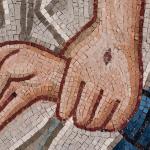by Edward Blum
R3 Contributor
It seemed like every few months an African American man had been murdered. It was one hundred years ago and Judge Lynch had taken the reigns from Lady Justice. He and the mobs working for him were not blind. They saw black men, women, children, and communities to terrorize. Judge Lynch didn’t carry a scale to be balanced. He gave his followers a noose to choke their victims. One hundred years ago in 1914, a reported 51 African Americans were lynched. The year after, 56.
One response then was to ask “where is Jesus Christ.” W. E. B. Du Bois, who had recently helped found the NAACP and served as the editor of its monthly magazine,The Crisis, tried to move the United States public to action. The Crisis tried to expose what was really happening throughout the United States — that African American communities were being systematically terrorized by everyday white Americans, by courts of law, by politicians, and by the police. They tried statistics. They tried muckraking. They tried every form of journalism they could.
W. E. B. Du Bois also tried faith. In response to lynchings, he wrote a series of short stories and poems that wrestled with the problem of racial violence in their midst. “Jesus Christ in Texas” was a short story set in Waco, Texas — where a lynching had recently taken place. It imagined a scenario where “a stranger” arrived in town. He looked neither white, nor black (he looked Jewish, in fact, but no one seemed to recognize those elements of his appearance). He spoke from the New Testament gospels to love one another, do unto others, and those old panaceas. Jesus met with convicts, one of whom was on the run from the police and Jesus exchanged clothing with him. A white pastor tried to determine who he was, muttering that he felt like he somehow knew this man, long ago. Ultimately, Jesus in Texas was lynched.
In poetry, Du Bois wondered where God was. In “A Litany for Atlanta,” he asked if God were asleep. Du Bois trembled: “God Surely Thou, too, are not white, O Lord, a pale, bloodless, heartless thing! / Ah! Christ of all the Pities!” Which would be worse, a dead God or a white one? Du Bois refused to believe either. He called with so many others, “Hear us, good Lord! / In night, O God of a godless land.”
Now, one hundred years later, was continue to ask, where is Jesus Christ in Ferguson, Missouri? Is God out there? As our young women and men are murdered, as our politicians seem idle, as those with guns wield bigger ones, where is the spirit of the man who tried to teach us to use right for might?
These are not new questions for American communities. African Americans have been calling for justice in this land of injustice for more than 400 years. At times, as during the Civil War and the Civil Rights movement, it seemed that God was with them. But for the vast majority of the rest of the centuries, the weight of history seems to indicate a silent and distant God. The shame of it all, perhaps, is not that God seems absent, but that those with the power and authority to do justice and to act humbly seem intent on the opposite.
Follow Edward J. Blum on Twitter: www.twitter.com/edwardjblum















